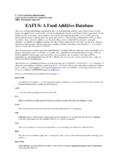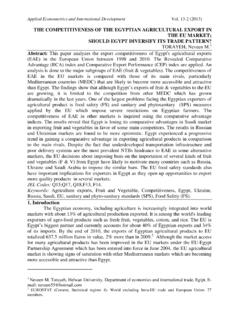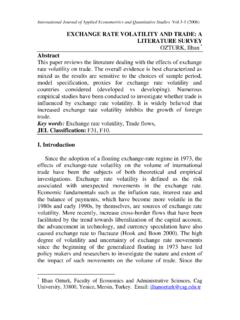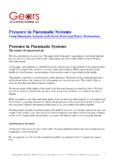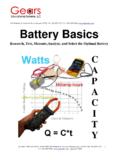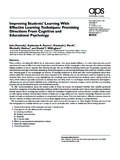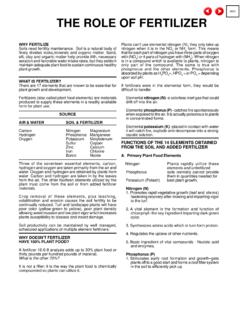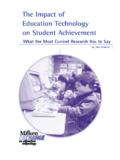Transcription of THE NIGERIAN EDUCATIONAL SYSTEM - Inicio - USC
1 International Journal of Applied Econometrics and Quantitative Studies (2006) THE NIGERIAN EDUCATIONAL SYSTEM AND RETURNS TO EDUCATION AMAGHIONYEODIWE, *OSINUBI, Abstract While each tier of education has at various times been the concurrent (joint) responsibility of both Federal and state governments, the former has historically been much more involved at the post secondary level. The shares of Federal Government recurrent and capital expenditures by level of education between 1996 and 2002. Over the period, the share for the (24) Federal universities has varied between roughly 40 and 50 percent of total Federal expenditures, while those for the (16) polytechnics and (20) colleges of education have remained fairly constant (apart from one year) at around 17 percent and 11 percent respectively.
2 Overall, during the whole period, the tertiary education sub sector has received between 68 percent and 80 percent of the total Federal expenditures for education. JEL Classification: I20, I22, O55 Keywords: EDUCATIONAL SYSTEM , Returns to Education, Universities Financing in Nigeria. 1. Introduction Education in Nigeria is more of a public enterprise that has witnessed government complete and dynamic intervention and active participation (Federal Republic of Nigeria, 1981). It is the view of the formulated education policy in Nigeria to use education as a vehicle in achieving national development. Education being an instrument of change, in Nigeria education policy has been a product of evolution through series of historical developments. * Lloyd Ahamefule Amaghionyeodiwe, Dep.
3 Of Economics, Faculty of Social Sciences, University of West Indies, Mona Campus, Kingston, Jamaica. Email: and Tokunbo Simbowale Osinubi, Department of Economics, Faculty of Social Sciences, University of Lagos, Akoka, Yaba, Lagos, Nigeria. Email: Journal of Applied Econometrics and Quantitative Studies (2006) The National Policy on Education in Nigeria was launched in 1977. The orientation of the policy is geared towards self-realization, individual and national efficiency, national unity etc. aimed at achieving social, cultural, economic, political, scientific and technological development. In 1985, the objectives of the policy were broadened to include free primary education among others. As noted by Anyanwu et al. (1999), this policy has been reviewed from time to time.
4 Until 1984, the structure of Nigeria education SYSTEM was 6 years of primary schools, 5 to 7 years of post primary schools (Secondary, Teacher Training College and sixth form) and 4 to 6 yrs of tertiary education (College of education, polytechnics, College of Technology and University education). From 1985, the structure that emanated can be classified thus, pre-primary or kindergarten education (2 to 3 yrs), for the children of ages 3 to5 years the primary school which is of 6 years period for children of ages 6 to 11 yrs, the post primary education which is of 6 years duration but divided unto two halves (3 years of Junior Secondary School and 3 years of Senior Secondary School) and the 4 to 6 of tertiary education level. This is called the 6-3-3-4 SYSTEM (Anyanwu et al.)
5 , 1999). Since the inception of the Obasanjo led administration in 1999, a Universal Basic Education Scheme was launched in 1999. The specific targets of the scheme are, total eradication of illiteracy by the year 2010 and increase in adult literacy rate from 57% to 70% by 2003 (FRN, 2000). 2. Sequence of Higher EDUCATIONAL Levels in Nigeria In Nigeria, there is a sequence of higher EDUCATIONAL levels. Three possible channels are illustrated in figure 1. The first channel assumes that a graduate went through NCE and then to the university. The other two channels are the more common ones, that is, those who went straight form secondary school to university and those who went through polytechnics to university. This assumption is predicated on experience from the labour markets 32 Amaghyonyeodiwe, and Osinubi, The NIGERIAN EDUCATIONAL SYSTEM and the years of schooling involved in each higher education levels, which place a higher value on university, polytechnics and NCE, in that order.
6 Figure 1: Possible Channels to Higher Education in Nigeria National College of Education Source: Adapted from Okuwa (2004) Second and as an alternative, the other higher levels of education ( NIGERIAN colleges of education and the polytechnics) are alternative routes after secondary education. Figure 2 illustrates this: Figure 2: Alternative Routes to Higher Education Source: Adapted from Okuwa (2004) Secondary Education Primary Education Polytechnic University (B) University (A) University (C) Primary education NIGERIAN Colleges of Secondary Education Polytechnics (E) Education (D) 33 International Journal of Applied Econometrics and Quantitative Studies (2006) With the first assumption, we are able to analyze the returns to an additional year of schooling among the higher education levels.
7 The second proposition enables us to examine the returns on higher education in relation to lower EDUCATIONAL level, and then compares the returns of the three channels of higher education. Out of the five possible channels of EDUCATIONAL attainment, the most prevalent route is B, that is, from primary education to secondary education to university education. This is so because this route takes a shorter time to achieve an EDUCATIONAL goal and cost less than any of the other routes. Most of the students who finish secondary school education and enter a polytechnic (for Ordinary National Diploma) or colleges of education do not stop these levels; they further their education by seeking university education. The prevalence of route B, followed by E, D, and A is supported by the number of student enrolled into these higher institutions.
8 3. Profile of Federal Government Expenditure on Education in Nigeria1 Education allocation as a percentage of total budgets ranged from in 1999 to in 1986. A close look at the distribution shows that the pattern of government budgetary allocation to education as a percentage of total budget was not consistent. Instead of maintaining an increasing proportion of the yearly budget, it has been largely fluctuating since introduction of SAP in 1986. Regardless of incessant strikes and negotiation to stimulate governments to increase the proportion, the proportion has been below 8% apart from 1994 and 2002, which were slightly above 9%. Since the oil crisis in the eighties, the proportion of capital budget allocated to education has been consistently lower than the proportion of recurrent expenditure.
9 Over the years, the government capital expenditure allocated to education as a percentage of total capital budget ranged from as low as in 1999 and not up to 9% in all cases. Like total budget, the proportion was also not consistent. 1 This subsection benefits substantially from Hinchliffe (2002). 34 Amaghyonyeodiwe, and Osinubi, The NIGERIAN EDUCATIONAL SYSTEM In 1998, expenditures were equivalent to percent of GDP and to percent of the total expenditures of the three tiers of government. A similar but more comprehensive exercise undertaken for 1962 indicated a share of GDP of percent and of total government expenditure of percent. Further, on average for 19 sub-Saharan African countries in the mid 1990s, education expenditures were equal to percent of GDP and percent of government expenditure.
10 Precisely, Federal Government expenditures on education are below 10 percent of its overall expenditures (see Table 1). Overall, the shares have varied between and percent and the trend has been largely downward. Typically, between 70 and 80 percent of expenditures are for recurrent activities. However, in 2000, the capital allocation increased to 45 percent of the total, in line with the overall large increase in capital expenditure in the Federal Government s budget. Table 1: Federal Government Expenditures on Education as Share of Total Federal Expenditure, 1997 2002 in Percentages. 199719981999 Capital Total Source: Federal Government of Nigeria, Annual Budget (various years).

